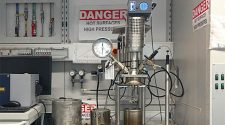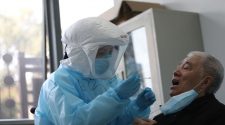Healthcare is huge. In 2017, healthcare spending in the U.S. totaled $3.5 trillion — nearly 18% of the country’s gross domestic product (GDP), which is the total market value of all products and services produced. Worldwide healthcare spending topped $7.7 billion. By 2022, global healthcare spending will reach at least $10 trillion, according to professional services firm Deloitte.
Where there’s a lot of money being spent, there are opportunities for investors. While one option is to buy individual healthcare stocks, many investors might prefer going with healthcare-focused exchange-traded funds (ETFs), which let you buy a basket of stocks with one transaction. But you don’t want to buy just any healthcare ETF. Here’s what you need to know about the top healthcare ETFs and why investing in them is something you should consider.
Image source: Getty Images.
Why healthcare is hot
Probably the most important trend fueling growth in healthcare is the aging of populations across the world. In the U.S., around 10,000 baby boomers turn 65 every day. By 2030, all of the 61 million American baby boomers will be at least 65 years old. By 2034, Americans 65 and older will outnumber those under 18 for the first time in U.S. history, according to projections from the U.S. Census Bureau.
In Europe, 1 out of every 4 residents already is at least 60 years old. Lower birth rates in Europe mean that populations will age even more rapidly than in the U.S. It’s a similar story in Asia, with a United Nations report finding that “all countries in Asia and the Pacific are in the process of aging at an unprecedented pace.”
As people age, they’re more likely to require healthcare services. And as demand rises, companies that provide products and services to address healthcare issues for aging populations should benefit.
In addition, significant advances are being made in healthcare and new technology is likely to generate tremendous growth for pioneering companies.
For example, drugmakers are developing new approaches that could revolutionize how diseases are treated. The use of personalized medicine, where individuals’ genetic information is used to determine the appropriate therapy, is picking up momentum. This is especially true in cancer treatment, where hundreds of immunotherapies that harness the body’s immune system to fight cancer are in clinical testing, with several immunotherapies already on the market. Biotechs and pharmaceutical companies are even using gene editing to cure rare genetic diseases that in the past had no effective treatment available.
Diagnostics companies are developing ways to detect cancer at early stages using liquid biopsies that identify fragments of DNA that have broken off from tumors and made their way into patients’ blood. Medical device companies are launching new devices that use artificial intelligence, robotics, and other advanced technology to improve the delivery of healthcare services.
There’s also a major focus among healthcare companies to provide products and services that help control the rising costs that are associated with higher demand. The use of telehealth — the delivery of healthcare services remotely using technology, especially the internet — is being adopted more widely. Surgical robots are being used to perform minimally invasive surgeries that in the past required much more complicated and risky procedures. Technology to monitor patients with chronic conditions and alert healthcare professionals when issues arise is helping reduce expensive hospital visits.
Rapidly growing demand fueled by aging populations across the world. Amazing new innovations that are revolutionizing patient care. It’s no wonder that healthcare is a hot area for investors.
Why use ETFs to invest in healthcare
There’s one big reason why using an ETF to invest in healthcare is a great idea: It provides diversification across lots of individual healthcare stocks. Each of the top five healthcare ETFs holds positions in at least 57 stocks, with three of the ETFs holding more than 100 stocks.
This diversification across multiple stocks lowers the amount of risk taken by investors. If only a small number of individual stocks drop significantly, the rest of the stocks owned by the ETF can offset those declines. Because the healthcare sector is so broad in scope, all healthcare stocks don’t necessarily move in the same direction all of the time. For example, regulations specific to medical device makers could hurt medical device stocks but not impact pharmaceutical stocks at all.
Using ETFs also enables investors to target specific industries within healthcare. For example, some healthcare ETFs focus only on biotech stocks or medical device stocks rather than the entire healthcare sector. Of course, you do lose some of the benefits of diversification by investing in these industry-specific ETFs.
So now that you know that ETFs offer the advantage of investing in a wide range of stocks in one fell swoop, let’s look at which healthcare ETFs are especially popular.
Five top healthcare ETFs
An important metric for healthcare ETFs is their assets under management. This refers to the total market value (how much a stock or other holding can be sold for) of all the financial assets that the ETF manages on behalf of its clients. The larger the assets under management, the more money investors have poured into the ETF, which reflects a broad level of confidence in the ETF. The five top healthcare ETFs — as measured by assets under management — are:
| Healthcare ETF |
Assets Under Management |
Number of Holdings |
|---|---|---|
|
Health Care Select Sector SPDR Fund (NYSEMKT:XLV) |
$17.3 billion | 61 |
| Vanguard Health Care Index Fund ETF (NYSEMKT:VHT) | $10 billion | 389 |
| iShares Nasdaq Biotechnology ETF (NASDAQ:IBB) | $6.7 billion | 219 |
| iShares U.S. Medical Devices ETF (NYSEMKT:IHI) |
$4.3 billion | 56 |
| SPDR S&P Biotech ETF (NYSEMKT:XBI) | $3.7 billion | 118 |
Data sources: Fund companies. All data as of Oct. 17, 2019.
Health Care Select Sector SPDR Fund
The Health Care Select Sector SPDR Fund is managed by State Street Global Advisors. This ETF attempts to track the performance of the Health Care Select Sector Index, which includes all of the stocks in the healthcare sector that are listed in the broader S&P 500 index.
The ETF provides exposure for investors to stocks in multiple healthcare industries, including biotechnology, healthcare equipment and supplies, healthcare providers and services, healthcare technology, life sciences tools and services, and pharmaceuticals. The top holdings of the Health Care Select Sector SPDR Fund in terms of market value as of October 2019 include Johnson & Johnson, UnitedHealth Group, Merck, Pfizer, Abbott Laboratories, Medtronic, Amgen, Thermo Fischer Scientific, AbbVie, and Eli Lilly.
Since its inception in 1998, the Health Care Select SPDR Fund has delivered an average annual return of 8.07%. Over the last three years and five years, the ETF has provided average annual returns of 9.44% and 8.92%, respectively.
Many of the stocks held by the Health Care Select SPDR Fund pay dividends. As a result, the ETF offers an attractive dividend yield (annual dividend payments expressed as a percentage of the ETF’s net asset value per share over the last 12 months) of 1.62%. This dividend yield more than offsets the ETF’s low expense ratio (the fund’s operating expenses divided by the average total dollar value of its managed assets) of 0.13%. ETFs deduct these expense ratios from investors’ accounts.
Vanguard Health Care Index Fund ETF
Vanguard pioneered the use of ETFs. The company’s biggest healthcare ETF in terms of assets under management is the Vanguard Health Care Index Fund ETF, which tracks the performance of the MSCI U.S. Investable Market Index (IMI)/Health Care 25/50. This benchmark index consists of stocks of large, midsize, and small U.S. healthcare companies based on market cap (the total dollar value of a company’s shares).
The Vanguard Health Care Index Fund ETF primarily holds positions in the stocks of companies that provide medical or healthcare products, services, technology, or equipment. Like the Health Care Select SPDR Fund, the ETF’s largest holdings as of October 2019 are Johnson & Johnson, UnitedHealth Group, Merck, Pfizer, Abbott Labs, Medtronic, Amgen, Thermo Fisher Scientific, AbbVie, and Eli Lilly.
This healthcare ETF has generated an average annual return of 9.47% since its launch in 2004. It has delivered average annual returns of 9.78% and 9.2% over the last three years and five years, respectively.
The Vanguard Health Care Index Fund ETF currently offers a dividend yield of 2.1%. Its expense ratio of 0.10% ranks as one of the lowest among all ETFs.
iShares Nasdaq Biotechnology ETF
The iShares Nasdaq Biotechnology ETF is managed by BlackRock. This ETF attempts to track the performance of the Nasdaq Biotechnology Index, which consists of U.S. biotechnology and pharmaceutical stocks that are listed on the Nasdaq stock exchange.
As its name indicates, the ETF focuses mainly on biotech stocks. Its largest holdings as of October 2019 include Amgen, Gilead Sciences, Celgene, Vertex Pharmaceuticals, Illumina, Biogen, Regeneron Pharmaceuticals, Alexion Pharmaceuticals, Incyte, and Seattle Genetics.
Since its launch in 2001, the iShares Nasdaq Biotechnology ETF has provided investors an average annual return of 6.2%. Over the last three years, the ETF has delivered an average annual return of 1.29%. The average annual return over the last five years was 1.97%.
Most biotech stocks don’t pay dividends. It’s not surprising, therefore, that the iShares Nasdaq Biotechnology ETF’s dividend yield of 0.27% is much lower than the yields offered by ETFs that target the broader healthcare sector. The ETF’s expense ratio of 0.47% is also higher than the ETFs that own holdings in more stocks across the healthcare spectrum.
iShares U.S. Medical Devices ETF
BlackRock also manages the iShares U.S. Medical Devices ETF. This ETF attempts to track the performance of the Dow Jones U.S. Select Medical Equipment Index, which includes selected medical equipment stocks.
The iShares U.S. Medical Devices ETF focuses only on stocks of companies that derive all or a significant portion of their total revenue by selling medical devices. The ETF’s largest holdings as of October 2019 include Abbott Labs, Medtronic, Thermo Fisher Scientific, Danaher, Edwards Lifesciences, Stryker, Becton Dickinson and Co., Baxter International, Intuitive Surgical, and Boston Scientific.
BlackRock launched the iShares U.S. Medical Devices ETF in 2006. Since then, the ETF has delivered an average annual return of 13.17%. Over the last three years and five years, it has provided annual average returns of 19.83% and 20.71%, respectively.
This ETF’s dividend yield currently stands at 0.3%. That level is nearly enough to cover the ETF’s expense ratio of 0.43%.
SPDR S&P Biotech ETF
State Street’s SPDR S&P Biotech ETF attempts to track the performance of the biotechnology segment of the S&P Total Market Index, which tracks the broader U.S. equity market.
While the iShares Nasdaq Biotechnology ETF and the SPDR S&P Biotech ETF both focus on biotech stocks, their top holdings are very different. The SPDR S&P Biotech ETF includes larger positions in small and midsize biotechs than the iShares ETF does. The largest holdings of the SPDR S&P Biotech ETF as of October 2019 are Seattle Genetics, Arrowhead Pharmaceuticals, The Medicines Company, Ligand Pharmaceuticals, Regeneron, AbbVie, Amgen, Celgene, Incyte, and United Therapeutics.
Since the inception of the SPDR S&P Biotech ETF in 2006, the ETF has generated an average annual return of 12.21%. Over the last three years, the ETF’s average annual return was 4.96%. It delivered an average annual return of 8.33% over the last five years.
You might think that an ETF with a lot of relatively smaller biotech stocks among its holdings would have a low dividend yield — and you’d be right. The SPDR S&P Biotech ETF’s dividend yield of 0.02% is the lowest of these five top healthcare ETFs. The ETF’s expense ratio of 0.35% is in the middle of the pack for the top healthcare ETFs.
Why consider these healthcare ETFs?
One key reason to consider investing in these five healthcare ETFs is that they claim strong average trading volumes (the average of how many shares are bought and sold over a given period). This means that there is plenty of liquidity, a term that refers to how quickly an asset can be bought or sold without affecting its price. You want high-liquidity investments in case you need to sell in a hurry.
And while your eyes might have glossed over reading about the expense ratios, they’re important. The lower expense ratios for these ETFs boost investment returns over time.
Should you just buy the healthcare ETF with the highest lifetime return? Nope. For one thing, future returns might not correlate with past returns. Also, these ETFs have different approaches. If you don’t want to focus only on medical device stocks, you wouldn’t want to go with the iShares U.S. Medical Devices ETF even though it claims the highest lifetime return.
Risks
Although buying a healthcare ETF reduces the risks for investors by diversifying across multiple stocks, there are still a number of key risks for these ETFs. Several, for example, have relatively large positions in certain stocks. If these stocks decline, they could cause the ETF to fall as well.
Abbott Labs makes up 13.53% of the total holdings of the iShares U.S. Medical Devices ETF. Johnson & Johnson makes up 10.14% and 8.6% of the Health Care Select Sector SPDR Fund and the Vanguard Health Care ETF, respectively. Over 9% of the iShares Nasdaq Biotechnology ETF is held in Amgen stock.
These heavy weightings make these ETFs especially susceptible to risks that could impact these stocks. Abbott Labs’ growth prospects could be hurt if it fails to win U.S. Food and Drug Administration (FDA) approval for its next version of the Freestyle Libre continuous glucose monitoring (CGM) system. Johnson & Johnson and Amgen face competition from biosimilar and generic rivals, which could negatively affect the companies’ growth prospects.
The good news, though, is that ETFs adjust their holdings as they see the need to do so. An ETF that suffers over the short term due to a large position in a stock that doesn’t perform well can still be a winner over the long term.
All of the top five healthcare ETFs could also experience significant declines as a result of major changes to the U.S. healthcare system. Biotechs and pharmaceutical stocks could feel the brunt of potential reforms to how drug prices are set, which could pull down all of the ETFs except the iShares U.S. Medical Devices ETF.
But this ETF isn’t immune from the negative effects of potential U.S. healthcare system changes. There is significant political support for a single-payer healthcare system in the U.S. It’s possible that nearly every healthcare stock could experience declines — and weigh on healthcare ETFs as well — if considerable progress is made toward implementing such a system.
Healthcare ETFs can withstand overall economic downturns better than many stocks since healthcare products and services usually are needed regardless of what’s going on with the economy, however, that doesn’t mean that they can’t fall during a recession or broader market pullback.
In 2008, for example, each of these five healthcare ETFs dropped by double-digit percentages at one point during the toughest part of the financial crisis. Two of these ETFs — the iShares Nasdaq Biotechnology ETF and the SPDR S&P Biotech ETF — ended down for the year and underperformed the broader S&P 500.
Positives outweigh the negatives
Despite these risks, the positives should outweigh the negatives for healthcare ETFs. The aging demographic trends discussed earlier will almost certainly drive higher demand for healthcare products and services over the long run.
While some companies might not fare as well as others, the indexes tracked by these ETFs follow the rules of survival of the fittest. If individual stocks underperform too much, they’ll be replaced in the indexes (and in the ETFs’ holdings) by better-performing stocks.
It’s not a bad idea to invest in healthcare stocks that appear to be in the best position to succeed over the long run. But for investors who either don’t want to do the research required to pick individual stocks or who prefer the lower risk resulting from diversification, healthcare ETFs are a great option.














